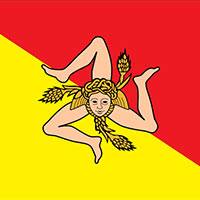La Martorana (Santa Maria dell'Ammiraglio)
The great admiral George of Antioch built the church Santa Maria dell'Ammiraglio in the mid 12th century in thanksgiving to the Mother of God for her protection during his long political and maritime activity.
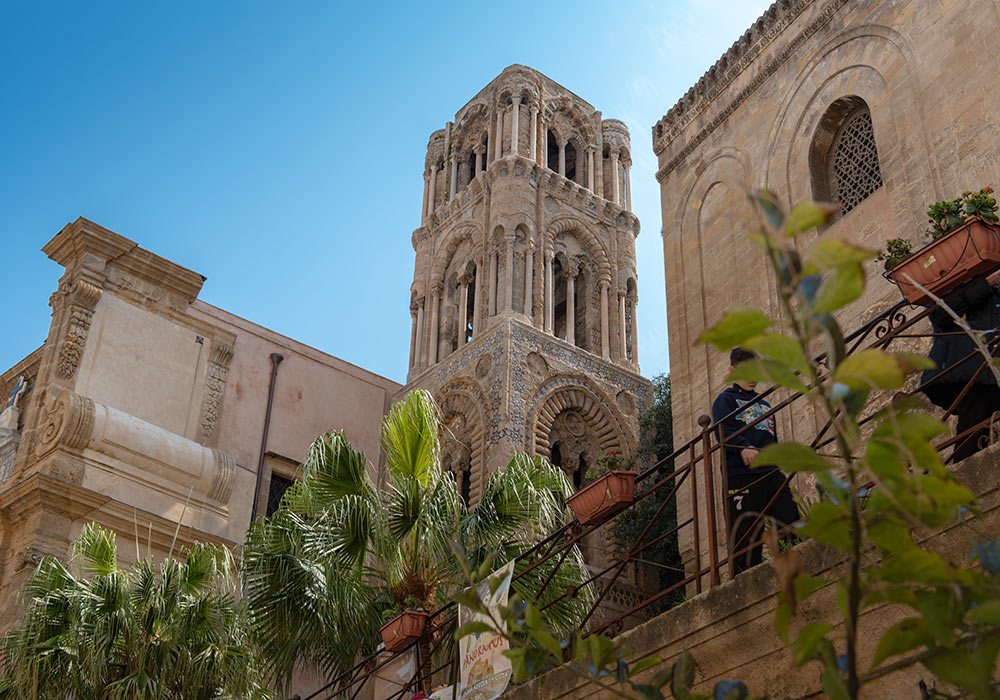
At the time George of Antioch was the Grand Admiral in the Kingdom of Sicily, the highest ranking officer after the Grand Constable. George had earned this title through his excellent results in the administration of a number of cities in Byzantine Syria and later for his predecessor Christodoulos a mission to Egypt and the African campaign (1131). In 1147 his piratic raids on Thebes and Corinth enabled him to bring silk weavers back to Palermo as slaves.
Originally the church had a Greek cross plane (a cross with four arms of equal length), but it has later been rebuilt several times.
After the Sicilian Vespers in 1282 the church housed a parliament of aristocrats and barons, swearing allegiance to King Peter of Aragon.
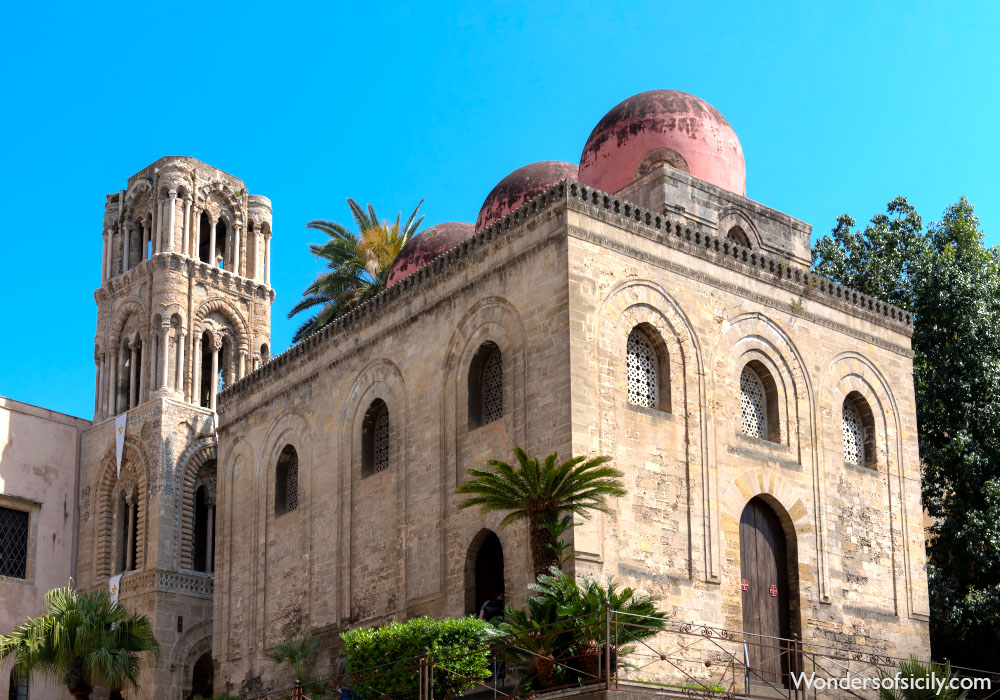
The church San Cataldo, with its characteristic red domes are situated next to Santa Maria dell'Ammiraglio.
Byzantine mosaic of the coronation of Roger II in Santa Maria dell'Ammiraglio
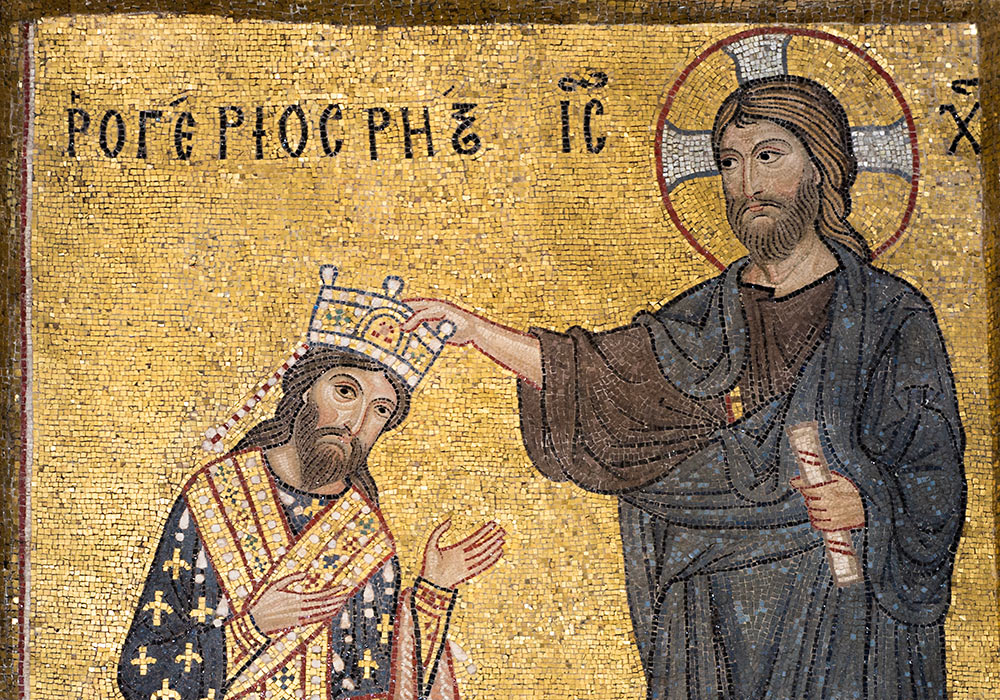
Roger II receiving the crown directly from Christ (and not the Pope). Mosaic in the Martorana church in Palermo. The mosaic carries an inscription Rogerios Rex in Greek letters. After the Sicilian Vespers of 1282 the island's nobility gathered in this church for a meeting that resulted in the Sicilian crown being offered to Peter III of Aragon.
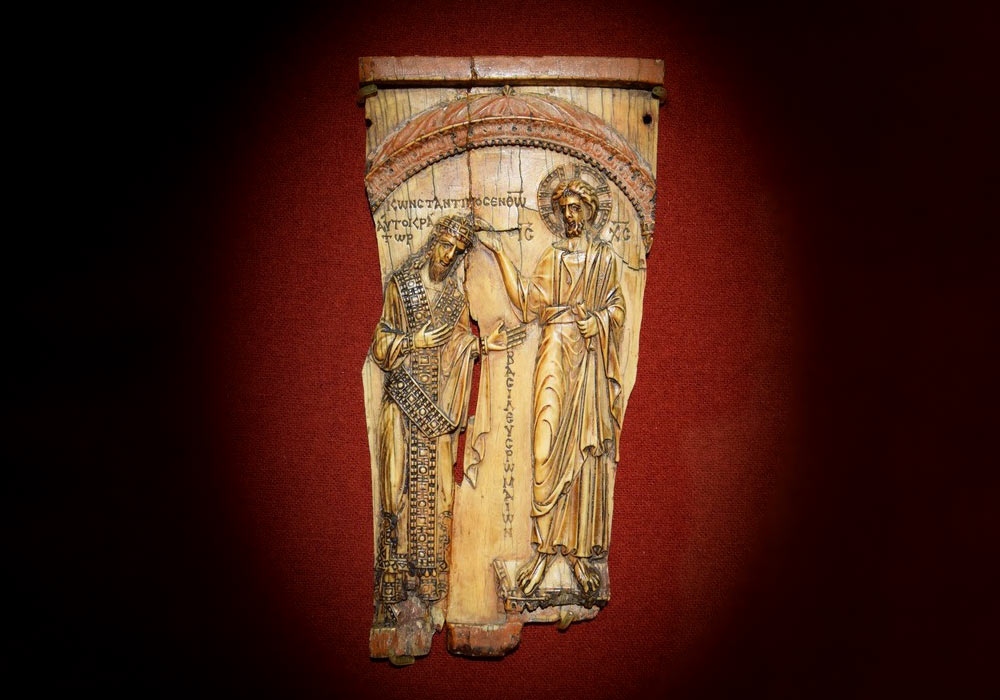
“The mosaic portraits of the kings crowned directly by Christ in George of Antioch’s church of Santa Maria dell’Ammariglio, and later at Monreale, had specific and very old Byzantine precedents that were both visual and conceptual; in this instance, a depiction in ivory of Christ’s coronation of Emperor Constantine VII Porphyrogenitos (d. 959).” (Alex Metcalfe: The Muslims of medieval Italy, p. 237) This ivory fragment can be seen in The Pushkin Museum, Moscow.
Photo: Wiener, J. B. (2017, November 13). Constantine VII & Christ. Ancient History Encyclopedia. Retrieved from https://www.ancient.eu/image/7624/ (CC BY-NC-SA 3.0)
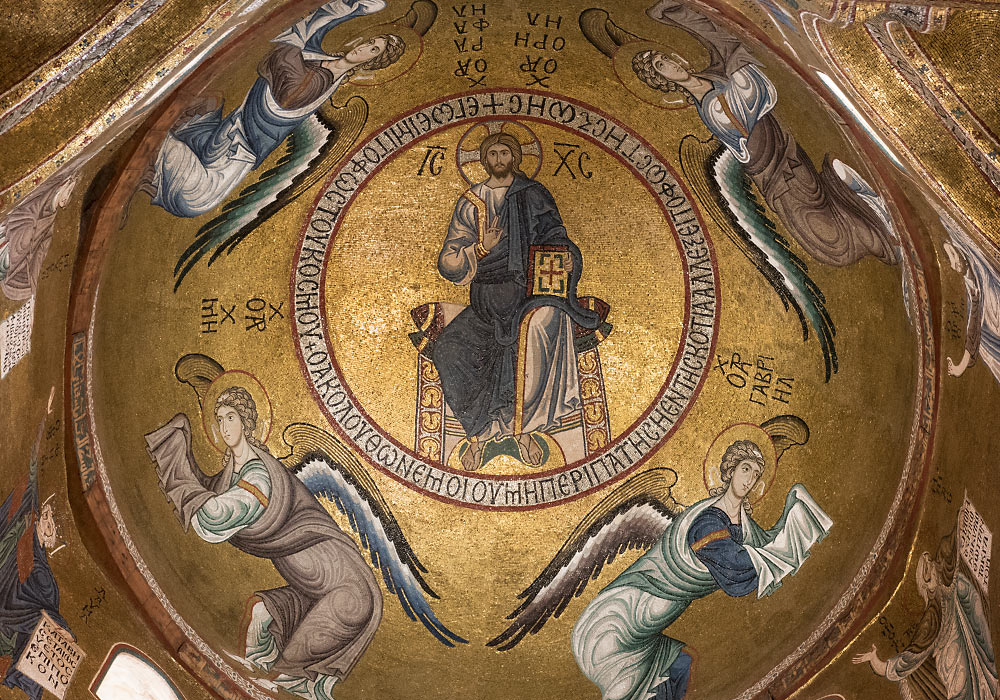
Christ Pantocrator in Martorana (Santa Maria dell'Ammiraglio), Palermo. The 12th century mosaics were executed by Byzantine craftsmen.
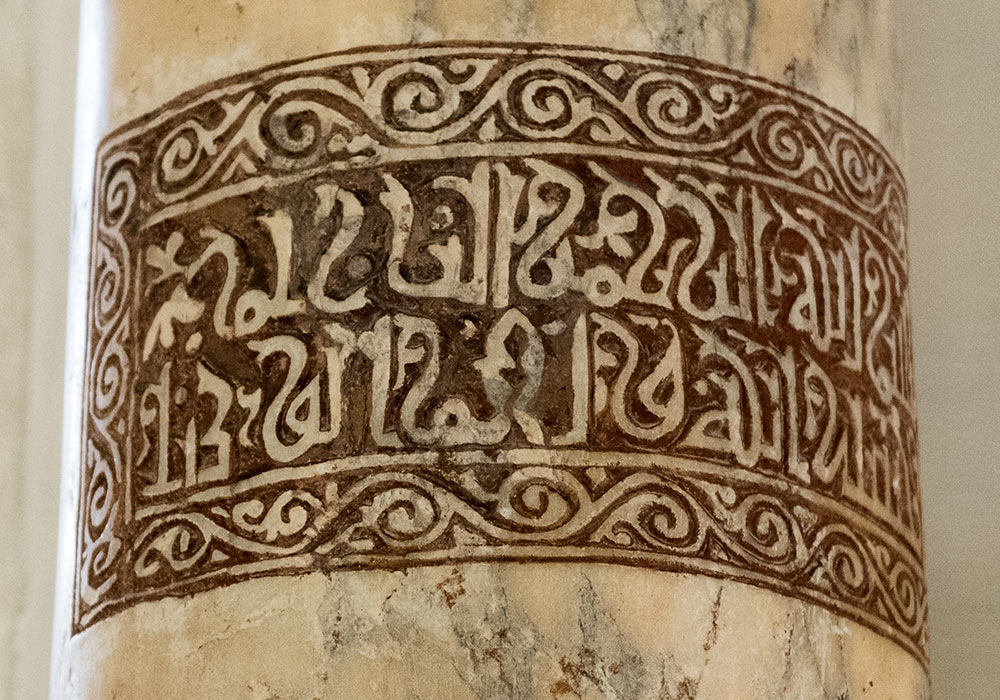
Islamic inscription on a column in La Martorana (Santa Maria dell'Ammiraglio), Palermo. The inscription (in Kufic, the oldest calligraphic form of the various Arabic scripts) reads:
In the name of God, the Merciful, the Compassionate, ("Basmala" - all prayers and chapters in the Quran starts with these words)
God is sufficient for me and He is the best advocate
Information about the columns in Santa Maria based on a passage in Jeremy Johns' article "The Arabic inscriptions of the Norman kings of Sicily: a reinterpretation" (link). Transcript errors are all mine since the Arabic letters (and transcript of them) are not available to me. Please check the original article for correct quotations:
Jeremy Johns states that these columns in all probability were originally employed in the porticoes of the forecourt, flanking the western entrance, and corresponding to the two dedicatory mosaic panels within. That which alludes to George bears two bands of inscription: the collar beneath the capital reads “Truly, God is with those who fear Him”, Qur'an 6: 128; and a panel in the middle of the shaft is inscribed with the hasbala, the motto introduced as an apprecatio in the Arabic documents of the royal diwan under the viziership of George of Antioch – “In the name of God, the Merciful, the Compassionate, God is sufficient for me and He is the best advocate”.
The explicitly Islamic tenor of these inscriptions suggest that this column was probably spolium from a religious building, and was reused in Santa Maria because of the close association between the hasbala and the vizier George. The second column is inscribed with four ad'iya (sorry, the correct letters not available) from the standard royal repertoire used by king Roger, and was presumably carved ex novo to provide a counterpart to the first inscribed column. Based on Jeremy Johns' article "The Arabic inscriptions of the Norman kings of Sicily: a reinterpretation". I am responsible for all errors.
The Basmala
The Basmala (Arabic: بسملة basmala), also known by its incipit Bismillah (Arabic: بسم الله, "In the name of God") is the name of the Islamic phrase "In the name of God, the Most Gracious, the Most Merciful". This is the phrase recited before each sura (chapter) of the Qur'an – except for the ninth. It is used by Muslims in various contexts (for instance, during daily prayer) and is usually the first phrase in the preambles to the constitutions of Islamic countries. (Wikipedia)
Kufic
Kufic script, an early form of Arabic calligraphy that was used to write the Arabic language. It is characterized by the use of straight and angular lines, and is often used to write the Quran (also romanized Koran or Qur'an), the sacred text of Islam. The name “kufic” comes from the city of Kufa, which was an important center of learning and scholarship in the early Islamic world. Kufa is a city in present-day Iraq with c. 110,000 inhabitants. The city is located about 170 kilometers south of Baghdad. It was founded in the 7th century CE, and quickly became an important center of learning and scholarship. Many of the early Islamic scholars, including the famous theologian Abu Hanifa, lived and worked in Kufa. The city is considered to be one of the birthplaces of the Shia branch of Islam (the second-largest branch of Islam), and it remains an important center of Shia scholarship and culture to this day.
Kufic calligraphy is highly respected in the Islamic world and is often used in the design of Islamic architectural elements, such as mosaics, tiles, and inscriptions on buildings. Famous examples in Sicily can be found on a column in La Martorana (Santa Maria dell'Ammiraglio) and on a column outside the cathedral in Palermo.
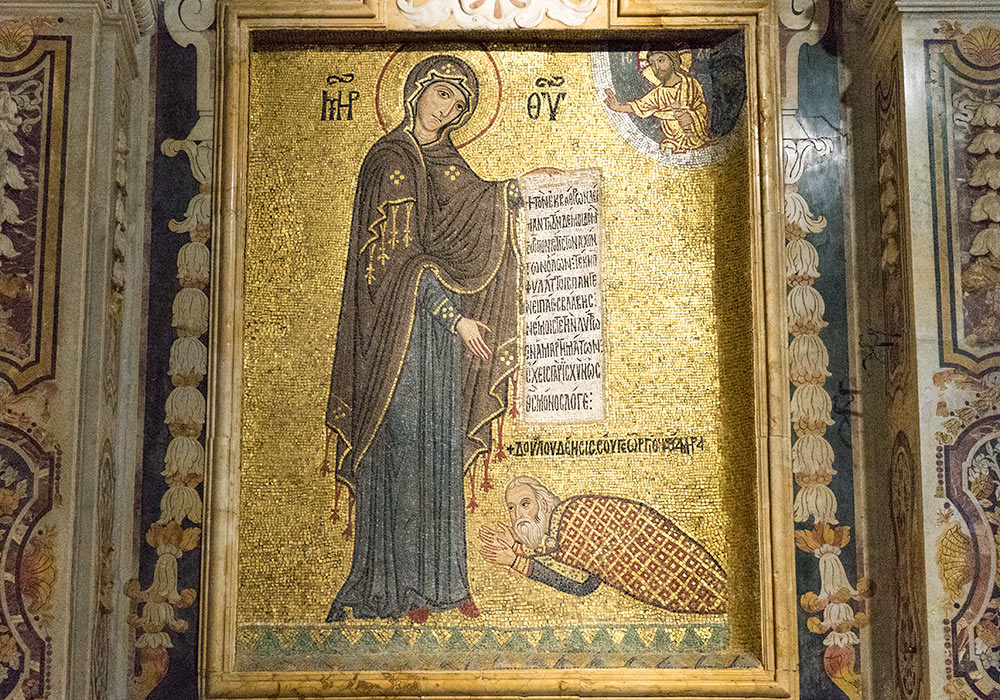
The great admiral George of Antioch at the feet of Virgin Mary. Byzantine mosaic in the Church of Martorana (1143), Palermo. The Virgin and the head of George are original, but George's body is the work of a later, not very successful, restoration. In 1857 Gaspare Palermo wrote in his guide book: “George is lying prostrate on the floor, with a white beard and white hair, richly dressed, his hand holding a rosary whose ‘Paternoster’ and ten ‘Ave’ beads can hardly be seen today.” Unfortunately, it seems that no drawings of the original has survived.
The Virgin Mary is holding a scroll bearing the following inscription in medieval Greek:
“He who built this house of mine from its very foundations, George, first among the first of all princes,o Son [Jesus Christ], protect him and his own people from harm and forgive him for his sins: for you are empowered to do so as the one and only God, o Word.” (as quoted in Rodo Santoro: Palermo: The Churches of the Martorana and San Cataldo.)
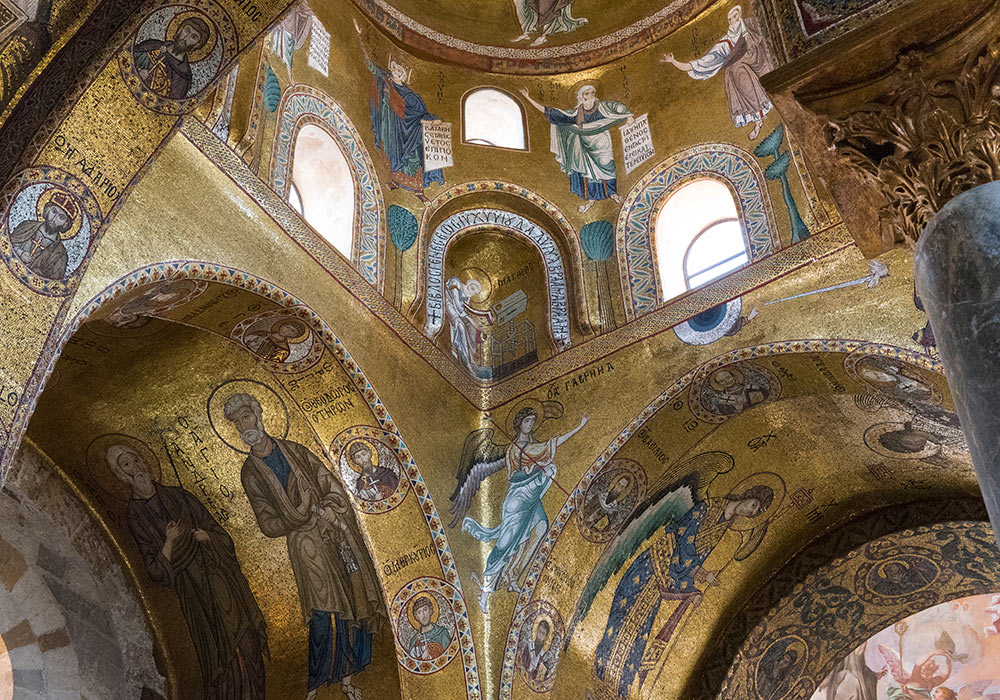
The golden mosaic interior of La Martorana (Santa Maria dell'Ammiraglio).
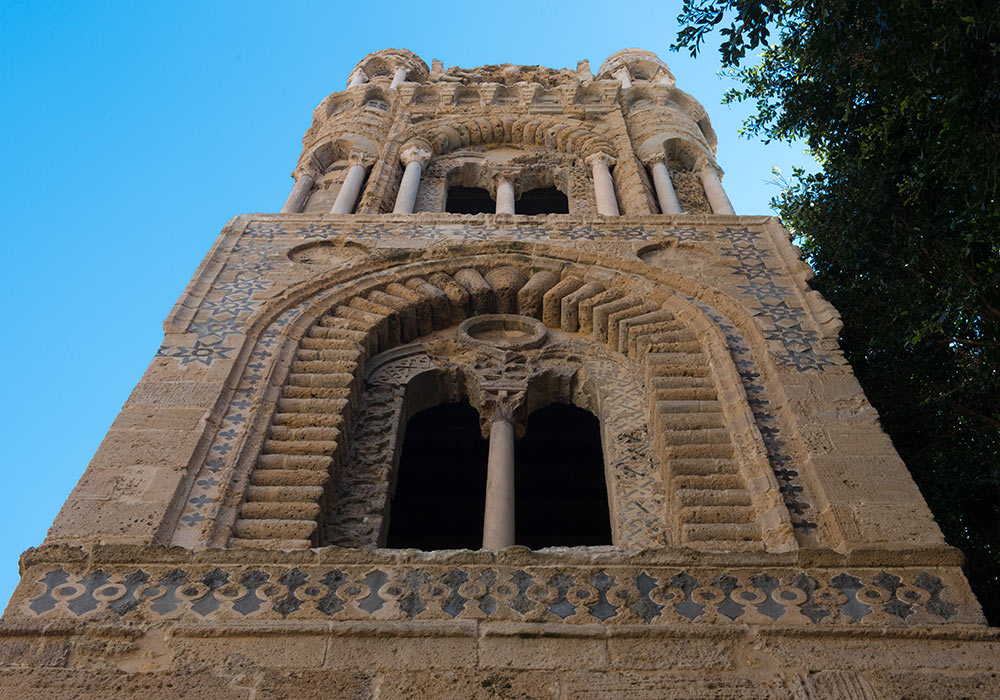
The Belltower.
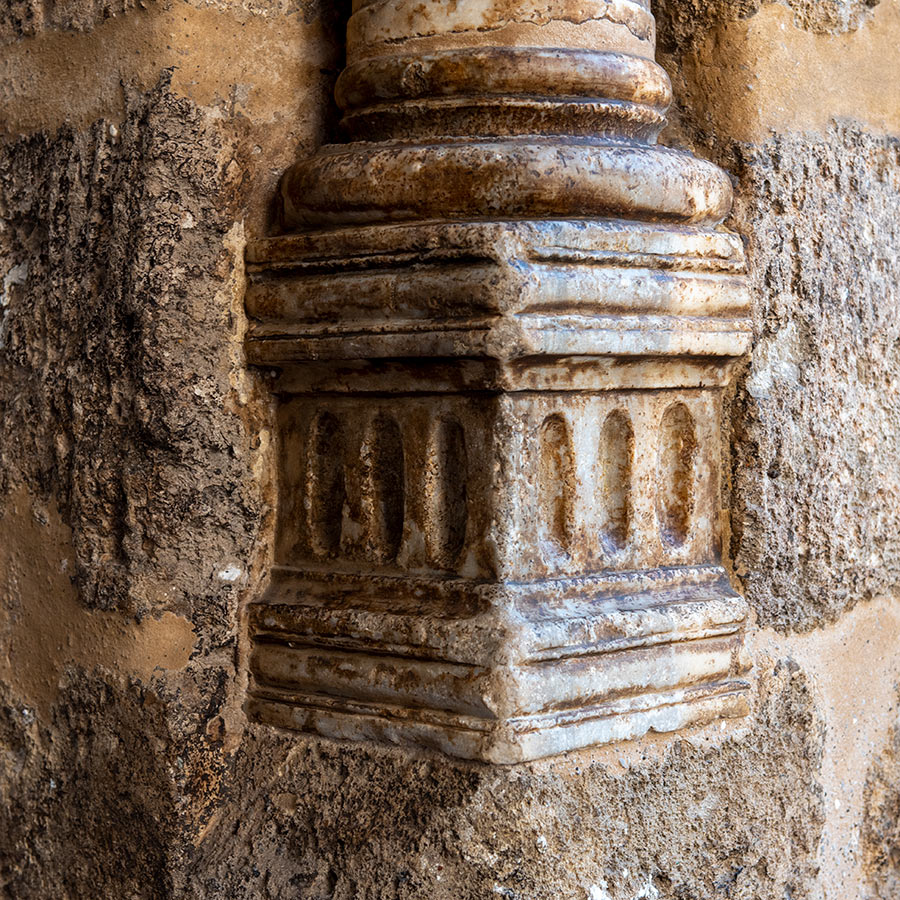
Partly visible column.
Facts about Sicily
- Sicily is the largest island in the Mediterranean.
- Sicily is the largest region in Italy.
- The terrain in Sicily is hilly. Plains and plateaus make up only 14% of the total land area.
- It is hard to believe for anyone having visited Sicily that the island once was well wooded. By the 17th century, there was not enough timber for local consumption. A lot of the forests disappeared during the long Roman Empire era (about 6 centuries). Sicily was the first grain supplier of the empire and the Romans deforested almost the entire island in order to enlarge the wheat crops.
- The Nobel Prize winner Luigi Pirandello was born near Agrigento.
- Boccaccio's Decameron Fifth Day - Novel VI takes place in the Cuba, Palermo (commissioned in 1180 by William II)
- Lemons, oranges, pistachio and sugar cane were brought to Sicily by the Arabs.
- Sicily’s greatest film director, Giuseppe Tornatore, was born, in Bagheria. His most famous film is Nuovo Cinema Paradiso.
The distance between Palermo and some other cities in Sicily
Palermo-Cefalù 69 km
Palermo-Siracusa 277 km
Palermo-Agrigento 131 km
Palermo-Noto 303 km
Palermo-Taormina 272 km
Palermo-Catania 227 km
Palermo-Trapani 101 km
Palermo-Corleone 57,8 km
Palermo-Villa Romana del Casale
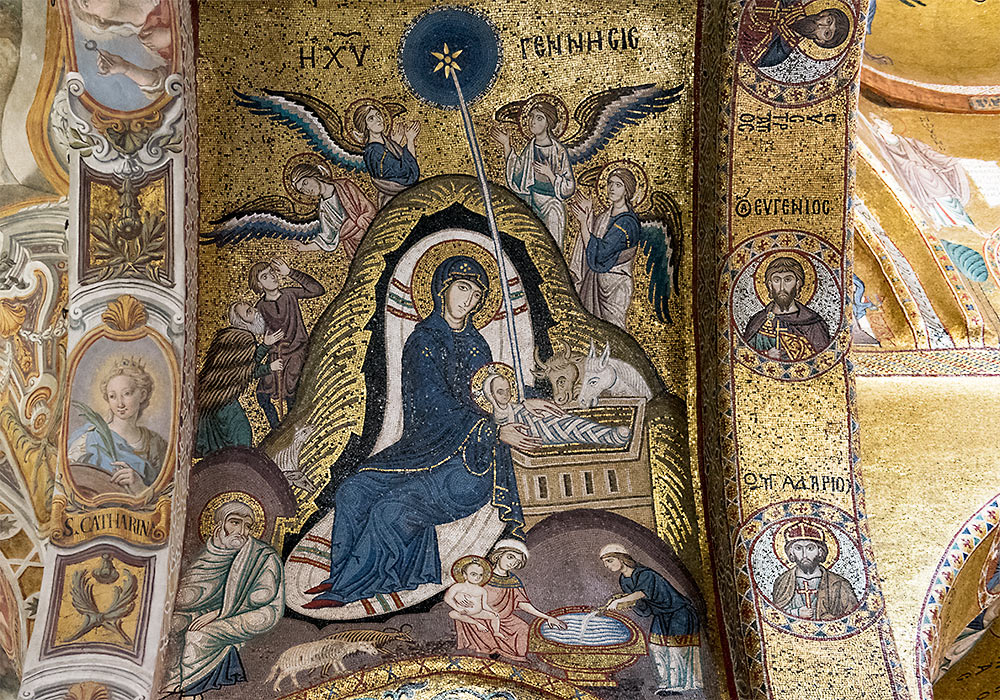
Mary and the child. Mosaic in the Martorana church.
(Main source: Palermo: The Churches of the "Martorana" and San Cataldo by Rodo Santoro, 2005)
Jean Paul Barreaud:
Docs, Reportages, Photos and Tours of Palermo.
Click here to book or read more!

